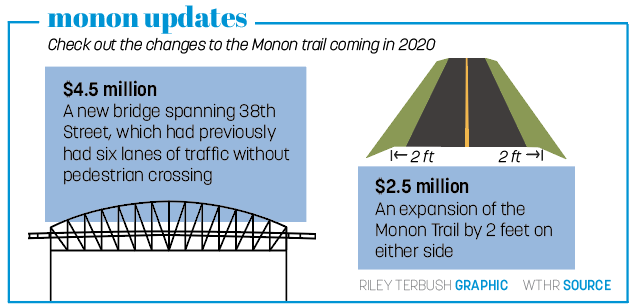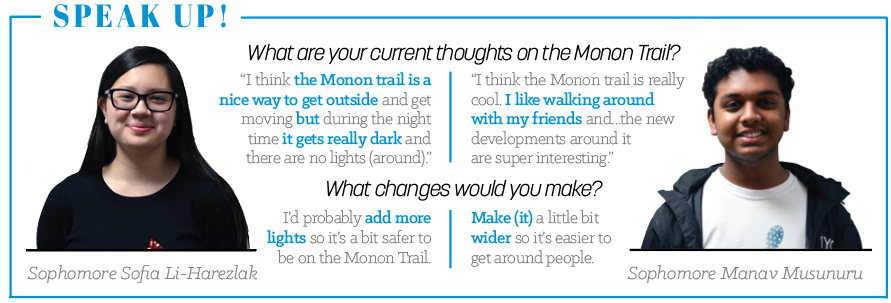The information in this issue—originally scheduled for publication on March 20—was written and produced prior to news regarding school cancellation from the COVID-19 virus. Some information may be outdated or inaccurate as a result.
Student staff members worked hard to produce this content and, despite the circumstances, we still wanted readers to have an opportunity to see it.
Thank you for your readership.
This past February, the City of Carmel was recognized by the League of American Bicyclists and awarded a bronze-level Bicycle Friendly Business award, contributing to the organization’s goal of helping to achieve a bike-friendly America. Nancy Heck, the City of Carmel’s Director of Community Relations and Economic Development, said being bicycle-friendly has been a goal for the city for the past several decades, but recent developments have led to the city receiving this award.
Heck said one of the major contributor to the city’s efforts to become more bike-friendly was more advertising and information about Carmel’s bike routes in order to make them more accessible to citizens.

Nancy Heck, Director of Carmel Community Relations and Economic Development, explains Carmel’s history with developing bike trails. According to Heck, one goal is to create a more bike-friendly environment
in Carmel.
“When we do most of our publications, we try and have some bike pictures (and) images mentioned, so people know and think about bikes when they come to Carmel. So in our Year in Review, we’ll mention our bikes,” Heck said. “When we have our list of events…we’ll have bike pictures in there,” Heck said. “We’re trying to get them to use bicycling (for) tourism because more people will come and bike for a tourist destination than golf. And we all know how popular golf is. We’re trying to get in that market so that when people think about bicycling, they think about Carmel.”
Kevin Whited, the City of Carmel Transportation and Development Coordinator, said another major factor the League of American Bicyclists looks for is the infrastructure of the city and how much the city incorporates bicycle-friendly infrastructure, because of important is infrastructure for increasing ridership numbers.
“We put these big 10-foot side paths so they’re really safe to ride down the roadways. As you build more of that, research shows the more bicycle-friendly infrastructure you have, the more people ride,” Whited said. “For every one-mile trail, it increases the bike ridership by (approximately) 0.25%, a very small percentage. But as you build up these trails, more people are welcome to ride.”
Sophomore Ethan Stoehr said he uses his bicycle as his primary mode of transportation. He said because Carmel has made an effort to be more bicycle-friendly, it makes it easy for him to get around.
“When you have the easy, accessible bike lanes and they’re spread out throughout the city, it’s really nice that you can get around without taking your car. And it’s obviously more sustainable,” Stoehr said. “When you do that, I feel like people are happier when you’re outside and you’re biking, as opposed to getting stuck in traffic.”
Heck said one of the primary reasons Carmel aims to be bike-friendly is the benefits to the citizens.

“(We want to be bicycle-friendly for) the health and well-being of the people that live in the community in general, and the sustainability of it, (by) cutting down the carbon emission that a lot of cars create. And (with) that lifestyle, there’s a really good mental health component of being able to get places in a slower way, and connecting with people on the street,” Heck said.
Whited said that in the future, there are plans in place to increase ridership numbers. The city plans to build a bike path along 136th Street towards College Avenue, advertise more bicycling events, and get more kids involved in bicycling by creating, Safety Towns, an innovative new public education initiative.
“(Safety Towns are) like a parking lot. But like they’re designed like a small town with roads and stuff, so you usually take grade school and middle school grade kids there and teach them how to ride on the road,” Whited said. “We’re going to work with commonplace schools in the parks department to run a lesson every third grader and then they run again through it in the sixth or seventh grade, but it’s always opened. (The) Cub Scouts can use it.”
While there are several plans in place, Stoehr said he hopes to see much more improvement on the bike paths throughout the city, especially near larger roadways.
“They’ve done a lot to increase bike lanes around Carmel. They’re expanding them out on trails and trying to make that a lot more pleasant. But as far as going East to West, I don’t think there’s a major bike lane,” he said. “They have bike lanes on the side of roads. The sidewalks are (there), but sometimes it’s choppy, (and) it stops (so) you have to go onto the road, which can be extremely annoying.”

































![AI in films like "The Brutalist" is convenient, but shouldn’t take priority [opinion]](https://hilite.org/wp-content/uploads/2025/02/catherine-cover-1200x471.jpg)








































![Review: “The Immortal Soul Salvage Yard:” A criminally underrated poetry collection [MUSE]](https://hilite.org/wp-content/uploads/2025/03/71cju6TvqmL._AC_UF10001000_QL80_.jpg)
![Review: "Dog Man" is Unapologetically Chaotic [MUSE]](https://hilite.org/wp-content/uploads/2025/03/dogman-1200x700.jpg)
![Review: "Ne Zha 2": The WeChat family reunion I didn’t know I needed [MUSE]](https://hilite.org/wp-content/uploads/2025/03/unnamed-4.png)
![Review in Print: Maripaz Villar brings a delightfully unique style to the world of WEBTOON [MUSE]](https://hilite.org/wp-content/uploads/2023/12/maripazcover-1200x960.jpg)
![Review: “The Sword of Kaigen” is a masterpiece [MUSE]](https://hilite.org/wp-content/uploads/2023/11/Screenshot-2023-11-26-201051.png)
![Review: Gateron Oil Kings, great linear switches, okay price [MUSE]](https://hilite.org/wp-content/uploads/2023/11/Screenshot-2023-11-26-200553.png)
![Review: “A Haunting in Venice” is a significant improvement from other Agatha Christie adaptations [MUSE]](https://hilite.org/wp-content/uploads/2023/11/e7ee2938a6d422669771bce6d8088521.jpg)
![Review: A Thanksgiving story from elementary school, still just as interesting [MUSE]](https://hilite.org/wp-content/uploads/2023/11/Screenshot-2023-11-26-195514-987x1200.png)
![Review: "When I Fly Towards You", cute, uplifting youth drama [MUSE]](https://hilite.org/wp-content/uploads/2023/09/When-I-Fly-Towards-You-Chinese-drama.png)
![Postcards from Muse: Hawaii Travel Diary [MUSE]](https://hilite.org/wp-content/uploads/2023/09/My-project-1-1200x1200.jpg)
![Review: "Ladybug & Cat Noir: The Movie," departure from original show [MUSE]](https://hilite.org/wp-content/uploads/2023/09/Ladybug__Cat_Noir_-_The_Movie_poster.jpg)
![Review in Print: "Hidden Love" is the cute, uplifting drama everyone needs [MUSE]](https://hilite.org/wp-content/uploads/2023/09/hiddenlovecover-e1693597208225-1030x1200.png)
![Review in Print: "Heartstopper" is the heartwarming queer romance we all need [MUSE]](https://hilite.org/wp-content/uploads/2023/08/museheartstoppercover-1200x654.png)




